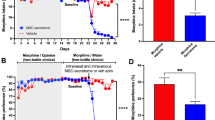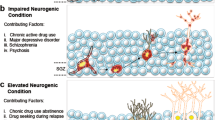Abstract
Studies reviewed show that lentiviral gene therapy directed either at inhibiting the synthesis of brain acetaldehyde generated from ethanol or at degrading brain acetaldehyde fully prevent ethanol intake by rats bred for their high alcohol preference. However, after animals have chronically consumed alcohol, the above gene therapy did not inhibit alcohol intake, indicating that in the chronic ethanol intake condition brain acetaldehyde is no longer the compound that generates the continued alcohol reinforcement. Oxidative stress and neuroinflammation generated by chronic ethanol intake are strongly associated with the perpetuation of alcohol consumption and alcohol relapse “binge drinking”. Mesenchymal stem cells, referred to as guardians of inflammation, release anti-inflammatory cytokines and antioxidant products. The intravenous delivery of human mesenchymal stem cells or the intranasal administration of mesenchymal stem cell-generated exosomes reverses both (i) alcohol-induced neuro-inflammation and (ii) oxidative stress, and greatly (iii) inhibits (80–90%) chronic alcohol intake and relapse binge-drinking. The therapeutic effect of mesenchymal stem cells is mediated by increased levels of the brain GLT-1 glutamate transporter, indicating that glutamate signaling is pivotal for alcohol relapse. Human mesenchymal stem cells and the products released by these cells may have translational value in the treatment of alcohol-use disorders.
This is a preview of subscription content, access via your institution
Access options
Subscribe to this journal
Receive 12 print issues and online access
$259.00 per year
only $21.58 per issue
Buy this article
- Purchase on Springer Link
- Instant access to full article PDF
Prices may be subject to local taxes which are calculated during checkout










Similar content being viewed by others
References
Mardones J, Segovia-Riquelme N. Thirty-two years of selection of rats by ethanol preference: UChA and UChB strains. Neurobehav Toxicol Teratol. 1983;5:171–8.
Quintanilla ME, Israel Y, Sapag A, Tampier L. The UChA and UChB rat lines: metabolic and genetic differences influencing alcohol intake. Addict Biol. 2006;11:310–23.
Bell RL, Rodd ZA, Lumeng L, Murphy JM, McBride WJ. The alcohol-preferring P rat and animal models of excessive alcohol drinking. Addict Biol. 2006;11:270–88.
Colombo G, Lobina C, Carai MA, Gessa GL. Phenotypic characterization of genetically selected Sardinian alcohol prferring rats (sp) and non-preferring (sNP) rats. Addict Biol. 2006;11:324–38.
Britton RS, Israel Y. Effect of 6-n-propyl-2-thiouracil on the rate of ethanol metabolism in rats treated chronically with ethanol. Biochem Pharmacol. 1980;29:2951–5.
Quertemont E, Tambour S. Is ethanol a pro-drug. The role of acetaldehyde in the central effects of ethanol. Trends Pharmacol. 2004;25:130–4.
Zimatkin SM, Pronko SP, Vasiliou V, Gonzalez FJ, Deitrich RA. Enzymatic mechanisms of ethanol oxidation in the brain. Alcohol Clin Exp Res. 2006;30:1500–5.
Aragon CM, Amit Z. The effect of 3-amino-1,2,4-triazole on voluntary ethanol consumption: evidence for brain catalase involvement in the mechanism of action. Neuropharmacology. 1992a;31:709–12.
Rotzinger S, Smith BR, Amit Z. Catalase inhibition attenuates the acquisition of ethanol and saccharin-quinine consumption in laboratory rats. Behav Pharmacol. 1994;5:203–9.
Tampier L, Quintanilla ME, Mardones J. Effects of aminotriazole on ethanol, water, and food intake and on brain catalase in UChA and UChB rats. Alcohol. 1995;12:341–4.
Orrico A, Hipólito L, Sánchez-Catalán MJ, Martí-Prats L, Zornoza T, Granero L, et al. Efficacy of D-penicillamine, a sequestering acetaldehyde agent, in the prevention of alcohol relapse-like drinking in rats. Psychopharmacology. 2013;228:563–75.
Peana AT, Porcheddu V, Bennardini F, Carta A, Rosas M, Acquas E. Role of ethanol-derived acetaldehyde in operant oral self-administration of ethanol in rats. Psychopharmacology. 2015;232:4269–76.
Rodd ZA, Bell RL, Zhang Y, Murphy JM, Goldstein A, Zaffaroni A, et al. Regional heterogeneity for the intracranial self-administration of ethanol and acetaldehyde within the ventral tegmental area of alcohol-preferring (P) rats: involvement of dopamine and serotonin. Neuropsychopharmacology. 2005;30:330–8.
Acquas E, Salamone JD, Correa M (eds). Ethanol, its active metabolites and their mechanisms of actions: Neurophysiological and Behavioral Effects. Front Behav Neurosci, 2018;12:95. https://doi.org/10.3389/fnbeh.2018.00095. Laussane: Frontiers Media https://doi.org/10.3389/978-2-88945-516-4.
Karahanian E, Quintanilla ME, Tampier L, Rivera-Meza M, Bustamante D, Gonzalez-Lira V, et al. Ethanol as a prodrug: brain metabolism of ethanol mediates its reinforcing effects. Alcohol Clin Exp Res. 2011;35:606–12.
Di Chiara G, Bassareo V. Reward system and addiction: what dopamine does and doesn’t do. Curr Opin Pharmacol. 2007;1:69–76.
Karahanian E, Rivera-Meza M, Tampier L, Quintanilla ME, Herrera-Marschitz M, Israel Y. Long-term inhibition of ethanol intake by the administration of an aldehyde dehydrogenase-2 (ALDH2)-coding lentiviral vector into the ventral tegmental area of rats. Addict Biol. 2015;20:336–44.
Quintanilla ME, Tampier L, Karahanian E, Rivera-Meza M, Herrera-Marschitz M, Israel Y. Reward and relapse: complete gene-induced dissociation in an animal model of alcoholism. Alcohol Clin Exp Res. 2012;36:517–22.
Tabakoff B, Anderson RA, Ritzmann RF. Brain acetaldehyde after ethanol administration. Biochem Pharmacol. 1976;25:1305–9.
Klyosov AA. Kinetics and specificity of human liver aldehyde dehydrogenases toward aliphatic, aromatic, and fused polycyclic aldehydes. Biochemistry. 1996;35:4457–67.
Chen CC, Lu RB, Chen YC, Wang MF, Chang YC, Li TK, et al. Interaction between the functional polymorphisms of the alcohol-metabolizing genes in protection against alcoholism. Am J Hum Genet. 1999;65:795–807.
Thomasson HR, Edenberg HJ, Crabb DW, Mai XL, Jerome RE, Li TK, et al. Alcohol and acetaldehyde dehydrogenase genotypes and alcoholism in Chinese man. Am J Hum Genet. 1991;48:677–81.
Ocaranza P, Quintanilla ME, Tampier L, Karahanian E, Sapag A, Israel Y. Gene therapy reduces ethanol intake in an animal model of alcohol dependence. Alcohol Clin Exp Res. 2008;32:52–57.
Garver E, Tu Gc, Cao QN, Aini M, Zhou F, Israel Y. Eliciting the low-activity aldehyde dehydrogenase Asian phenotype by an antisense mechanism results in an aversion to ethanol. J Exp Med. 2001;194:571–80.
Sapag A, Irrazábal T, Lobos-González L, Muñoz-Brauning CR, Quintanilla ME, Tampier L. Hairpin ribozyme genes curtail alcohol drinking: from rational design to in vivo effects in the rat. Mol Ther Nucleic Acids. 2016;7:e335.
Sanchez AC, Li C, Andrews B, Asenjo JA, Samulski RJ. AAV Gene therapy for alcoholism: inhibition of mitochondrial aldehyde dehydrogenase enzyme expression in hepatoma cells. Hum Gene Ther. 2017 28 :717–25. https://doi.org/10.1089/hum.2017.043.
Thapa B, Kumar P, Zeng H, Narain R. Asialoglycoprotein receptor-mediated gene delivery to hepatocytes using galactosylated polymers. Biomacromolecules. 2015;16:3008–20.
Liu K, Song G, Zhu X, Yang X, Shen Y, Wang W, et al. Association between ALDH2 Glu487Lys polymorphism and the risk of esophageal cancer. Medicine. 2017;96:e6111.
Israel Y, Hollander O, Sanchez-Craig M, Booker S, Miller V, Gingrich R, et al. Screening for problem drinking and counseling by the primary care physician-nurse team. Alcohol Clin Exp Res. 1996;20:1443–50.
Knox J, Wall M, Witkiewitz K, Kranzler HR, Falk D, Litten R, et al. Alcohol Clinical Trials (ACTIVE) Workgroup. Reduction in Nonabstinent WHO Drinking Risk Levels and Change in Risk for Liver Disease and Positive AUDIT-C Scores: Prospective 3-Year Follow-Up Results in the U.S. General Population. Alcohol Clin Exp Res. 2018;42:2256–65. https://doi.org/10.1111/acer.13884.
Crews FT, Vetreno RP. Mechanisms of neuroimmune gene induction in alcoholism. Psychopharmacology. 2016;233:1543–57.
Montesinos J, Alfonso-Loeches S, Guerri C. Impact of the innate immune response in the actions of ethanol on the central nervous system. Alcohol Clin Exp Res. 2016;40:2260–70.
Ferrier L, Berard F, Debrauwer L, Chabo C, Langella P, Bueno L, et al. Impairment of the intestinal barrier by ethanol involves enteric microflora and mast cell activation in rodents. Am J Pathol. 2006;168:1148–54.
Qin L, Wu X, Block ML, Liu Y, Breese GR, Hong JS, et al. Systemic LPS causes chronic neuroinflammation and progressive neurodegeneration. Glia. 2007;55:453–62.
Cunha-Oliveira T, Rego AC, Oliveira CR. Oxidative stress and drugs of abuse: an update. Org Chem. 2013;10:1–14.
Das SK, Vasudevan D. Alcohol-induced oxidative stress. Life Sci. 2007;81:177–87.
Ezquer F, Quintanilla ME, Morales P, Ezquer M, Lespay-Rebolledo C, Herrera-Marschitz, et al. Activated Mesenchymal stem cell administration inhibits alcohol drinking and supresses relapse-like drinking in high-alcohol drinker rats. Addiction Biol. 2017;18, https://doi.org/10.1111/adb.12572.
Kastl L, Sauer SW, Beissbarth R, Becker MS, Süss D, Krammer PH, et al. TNF-α mediates mitochondrial uncoupling and enhances ROS dependent cell migration via NF-kB activation in liver cells. FEBS Lett. 2014;588:175–83.
Alfonso-Loeches S, Pascual-Lucas M, Blanco AM, Sanchez-Vera I, Guerri C. Pivotal role of TLR4 receptors in alcohol-induced neuroinflammation and brain damage. J Neurosci. 2010;30:8285–95.
Blednov YA, Benavidez JM, Geil C, Perra S, Morikawa H, Harris RA. Activation of inflammatory signaling by lipopolysaccharide produces a prolonged increase of voluntary alcohol intake in mice. Brain Behav Immun. 2011;1 Suppl :S92–S105. https://doi.org/10.1016/j.bbi.2011.01.008.
McCarthy GM, Warden AS, Bridges CR, Blednov YA, Harris RA. Chronic ethanol consumption: role of TLR3/TRIF-dependent signaling. Addict Biol. 2018;23:889–903. https://doi.org/10.1111/adb.12539.
Leclercq S, de Timary P, Delzenne NM, Stärkel P. The link between inflammation, bugs, the intestine and the brain in alcohol dependence. Transl Psychiatry. 2017;7:e1048 https://doi.org/10.1038/tp.2017.15.
Sari Y, Toalston JE, Rao PSS, Bell RL. Effects of ceftriaxone on ethanol, nicotine or sucrose intake by alcohol-preferring (P) rats and its association with GLT-1 expression. Neuroscience. 2016;326:117–25.
Trotti D, Danbolt NC, Volterra A. Glutamate transporters are oxidant-vulnerable: a molecular link between oxidative and excitotoxic neurodegeneration? Trends Pharmacol Sci. 1998;9:328–34.
Lauderback CM, Hackett JM, Huang FF, Keller JN, Szweda LI, Markesbery WR, et al. The glial glutamate transporter, GLT-1, is oxidatively modified by 4-hydroxy-2-nonenal in the Alzheimer’s disease brain: the role of Abeta1-42. J Neurochem. 2001;78:413–6.
Prockop DJ, Oh JY. Mesenchymal stem/stromal cells (MSCs): role as guardians of inflammation. Mol Ther. 2012;20:14–20.
Israel Y, Ezquer F, Quintanilla ME, Morales P, Ezquer M, Herrera-Marschitz M. Intracerebral Stem cell administration inhibits relapse-like alcohol drinking in rats. Alcohol Alcohol. 2016;52:1–4.
Ezquer F, Quintanilla ME, Morales P, Ezquer M, Lespay-Rebolledo C, Herrera-Marschitz, et al. Activated mesenchymal stem cell administration inhibits chronic alcohol drinking and suppresses relapse-like drinking in high-alcohol drinker rats. Addict Biol. 2019;24:17–27. https://doi.org/10.1111/adb.12572.
Ezquer F, Morales P, Quintanilla ME, Santapau D, Lespay-Rebolledo C, Ezquer M, et al. Intravenous administration of anti-inflammatory mesenchymal stem cell spheroids reduces chronic alcohol intake and abolishes binge-drinking. Sci Rep. 2018a;8:4325 https://doi.org/10.1038/s41598-018-22750-7.
De Miguel MP, Fuentes-Julián S, Blázquez-Martínez A, Pascual CY, Aller MA, Arias J, et al. Immunosuppressive properties of mesenchymal stem cells: advances and applications. Curr Mol Med. 2012;12:574–91.
Ezquer F, Quintanilla ME, Morales P, Santapau D, Ezquer M, Kogan MJ, et al. Intranasal delivery of mesenchymal stem cell-derived exosomes reduces oxidative stress and markedly inhibits ethanol consumption and post-deprivation relapse drinking. Addict Biol. 2018b. https://doi.org/10.1111/adb.12675.
Volkman R, Offen D. Concise review: mesenchymal stem cells in neurodegenerative diseases. Stem Cells. 2017;35:1867–80.
Acknowledgements
Studies presented were supported by NIAAA R01AA 10630, ICM-P99-03, Fondecyt #1080447, #1095021; #1130012, #1150589, #1170712, and #1180042 (Chile).
Author contributions
YI and MEQ drafted the review and all authors contributed to improving the text and approved the final manuscript.
Author information
Authors and Affiliations
Corresponding author
Ethics declarations
Conflict of interest
The authors declare that they have no conflict of interest.
Additional information
Publisher’s note: Springer Nature remains neutral with regard to jurisdictional claims in published maps and institutional affiliations.
Rights and permissions
About this article
Cite this article
Yedy Israel, Quintanilla, M.E., Ezquer, F. et al. Gene and cell therapy on the acquisition and relapse-like binge drinking in a model of alcoholism: translational options. Gene Ther 26, 407–417 (2019). https://doi.org/10.1038/s41434-019-0064-9
Received:
Revised:
Accepted:
Published:
Issue Date:
DOI: https://doi.org/10.1038/s41434-019-0064-9
This article is cited by
-
Neuropsychosocial markers of binge drinking in young adults
Molecular Psychiatry (2021)
-
Mesenchymal stem cells as new perspective for the treatment of alcohol use disorder
Gene Therapy (2020)



